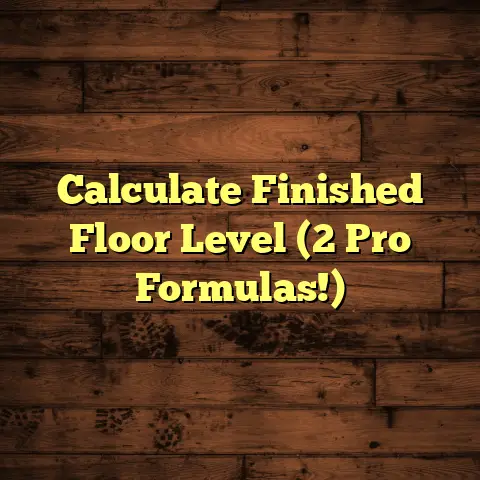How To Polish Terracotta Tiles? (4 Steps, Pro Finish!)
Terracotta tiles, with their earthy tones and rustic charm, bring a unique warmth to any space.
I’ve always loved the way they add character, whether it’s a sun-drenched patio or a cozy kitchen floor.
But let’s be honest, terracotta can lose its luster over time.
Dullness, stains, and everyday wear can take away from its natural beauty.
That’s where polishing comes in!
Think of polishing as giving your terracotta a spa day, bringing back its original glow.
And it’s not just about looks.
Proper maintenance, including polishing, extends the life of your tiles, protecting your investment.
I’m going to walk you through a simple, yet effective, four-step process for polishing your terracotta tiles.
Trust me, with a little elbow grease and the right techniques, you can achieve a professional finish that will make your terracotta shine!
Section 1: Understanding Terracotta Tiles
Let’s dive into what makes terracotta so special.
The word “terracotta” literally means “baked earth” in Italian.
That hints at its origins – a craft dating back centuries!
From ancient pottery to architectural marvels, terracotta has been used across cultures for its durability and natural beauty.
What makes terracotta unique?
Well, it’s a porous material, meaning it absorbs liquids.
This gives it a lovely, earthy texture and those warm, natural colors we adore.
But that porosity also means it’s prone to staining if not properly sealed and maintained.
Terracotta offers some great advantages.
It’s breathable, helping to regulate humidity in your home.
It’s also an eco-friendly choice, made from natural clay.
Plus, that rustic aesthetic? Timeless!
I often see terracotta used in kitchens, patios, entryways, and sunrooms.
These areas see a lot of foot traffic and are exposed to spills and the elements.
This means they need extra TLC to keep those terracotta tiles looking their best.
Section 2: Preparing for the Polishing Process
Alright, let’s gather our supplies!
Here’s what you’ll need to get started:
- Mop and Bucket: For cleaning.
- pH-Neutral Cleaner: Crucial! Acidic cleaners can damage terracotta.
- Polishing Compound: Specifically designed for natural stone or terracotta.
- Soft Cloths or Buffing Pads: Microfiber cloths work wonders.
- Sealer (Terracotta Specific): To protect your newly polished tiles.
- Gloves: To protect your hands.
- Optional: Knee Pads: Trust me, your knees will thank you!
Before we even think about polishing, we need a clean slate.
That means removing all the dirt, grime, old wax, or sealant.
Start by sweeping or vacuuming the area thoroughly.
Then, mix your pH-neutral cleaner with water according to the product instructions.
Mop the floor, paying attention to any stubborn stains.
You might need to scrub a bit with a soft brush.
Rinse well with clean water and let the tiles dry completely.
This is super important! Polishing wet tiles is a no-go.
Now, how do you know if your tiles have been previously treated with a sealant or wax?
Here’s a simple test:
Find an inconspicuous area and apply a small amount of water.
If the water beads up, there’s likely a sealant present.
If it soaks in quickly, the tiles are likely bare.
If there is a sealant, you may need to use a sealant remover before polishing.
Follow the manufacturer’s instructions carefully.
Take a good look at your tiles.
Are there any cracks, chips, or damaged areas?
These need to be addressed before polishing.
You can use a terracotta repair compound to fill in any imperfections.
Let it dry completely and sand it smooth before moving on.
Section 3: The 4 Steps to Polish Terracotta Tiles
Okay, the moment we’ve been waiting for!
Let’s get those terracotta tiles shining!
Step 1: Deep Cleaning the Tiles
We already did a preliminary clean, but now we’re going deeper.
Mix your pH-neutral cleaner with warm water, following the instructions on the bottle.
I like to use a slightly stronger concentration for this deep clean.
Using a mop or sponge, apply the cleaning solution to the tiles.
Let it sit for a few minutes to loosen any remaining dirt and grime.
Now, grab a scrub brush (nothing too abrasive!) and get to work.
Focus on grout lines and areas with stubborn stains.
Circular motions work best.
Once you’ve scrubbed the entire area, rinse thoroughly with clean water.
Make sure to remove all traces of the cleaning solution.
Drying is crucial.
You can use clean towels to dry the tiles, or let them air dry completely.
I prefer using towels because it’s faster.
Make sure the tiles are bone dry before moving on to the next step.
Step 2: Applying a Polishing Compound
What exactly is a polishing compound?
It’s a product designed to gently abrade the surface of the tile, removing micro-scratches and restoring shine.
Think of it like exfoliating your skin, but for your terracotta!
Choose a polishing compound specifically designed for natural stone or terracotta.
Read the product instructions carefully before you begin.
Apply a small amount of polishing compound to a clean, soft cloth or buffing pad.
Working in small sections (about 2×2 feet), apply the compound to the tiles using circular motions.
Apply even pressure to ensure consistent coverage.
Don’t apply too much compound at once!
A little goes a long way. You want a thin, even layer.
Let the compound sit on the tiles for the amount of time recommended by the manufacturer.
This allows it to work its magic.
Step 3: Buffing the Tiles for Shine
Buffing is where the real magic happens!
This is what brings out the shine and makes your terracotta glow.
You’ll need a clean, dry soft cloth or a buffing pad attached to a floor buffer.
If you’re doing a large area, a floor buffer is a lifesaver.
For smaller areas, elbow grease and a good cloth will do the trick.
If you’re using a floor buffer, start with a low speed setting.
If you’re using a cloth, fold it into a comfortable pad.
Working in the same small sections you used for the polishing compound, buff the tiles using circular motions.
Apply moderate pressure.
You don’t want to press too hard, but you need enough pressure to generate friction and create shine.
As you buff, you’ll start to see the tiles become noticeably shinier.
This is so satisfying!
Continue buffing until you’ve achieved the desired level of shine.
You may need to go over some areas multiple times.
Once you’ve buffed the entire area, use a clean cloth to remove any remaining polishing compound residue.
Step 4: Sealing the Polished Tiles
You’ve put in the work to polish your tiles.
Now, you need to protect that shine!
Sealing is essential for preventing stains, water damage, and general wear and tear.
Choose a sealer specifically designed for terracotta tiles.
There are two main types: penetrating sealers and surface sealers.
Penetrating sealers soak into the tile and protect it from within.
Surface sealers create a protective layer on top of the tile.
I generally recommend penetrating sealers for terracotta because they allow the tile to breathe.
Read the product instructions carefully before applying the sealer.
Apply the sealer to the tiles using a clean mop, brush, or applicator pad.
Apply a thin, even coat.
Allow the sealer to penetrate the tiles for the amount of time recommended by the manufacturer.
Wipe away any excess sealer with a clean cloth.
This is important! Excess sealer can leave a sticky residue.
Allow the sealer to dry completely.
This usually takes several hours, or even overnight.
Check the product instructions for specific drying times.
You may need to apply a second coat of sealer for added protection.
Follow the same steps as above.
Section 4: Maintaining Your Polished Terracotta Tiles
You’ve got your beautifully polished and sealed terracotta tiles!
Now, let’s keep them that way.
Regular cleaning is key.
Sweep or vacuum regularly to remove dirt and debris.
This prevents scratching and dulling of the finish.
When you mop, use a pH-neutral cleaner specifically designed for natural stone.
Avoid harsh chemicals, abrasive cleaners, and acidic substances like vinegar or lemon juice.
These can damage the sealer and the terracotta itself.
Wipe up spills immediately to prevent staining.
Terracotta is porous, so spills can soak in quickly.
Place mats at entrances to trap dirt and moisture.
This will help protect your tiles from wear and tear.
Even with the best care, your terracotta tiles will eventually need to be re-polished and re-sealed.
How often you need to do this depends on the amount of traffic and wear they receive.
As a general rule, I recommend re-sealing your terracotta tiles every 1-2 years.
Re-polishing can be done less frequently, as needed.
Here’s a simple maintenance schedule to follow:
- Daily: Sweep or vacuum.
- Weekly: Mop with a pH-neutral cleaner.
- As Needed: Wipe up spills immediately.
- Every 1-2 Years: Re-seal.
- As Needed: Re-polish.
Conclusion
So there you have it!
Polishing terracotta tiles is a rewarding project that can dramatically enhance the beauty and longevity of your floors.
With these four simple steps – deep cleaning, polishing compound application, buffing, and sealing – you can achieve a professional finish that will make your terracotta shine for years to come.
Don’t be intimidated!
With a little patience and the right tools, anyone can do it.
Now, go forth and transform your terracotta tiles!
You’ll be amazed at the difference it makes.
Happy polishing!





